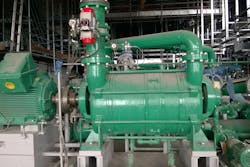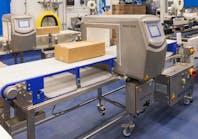What processing engineers should know about vibration of pumps, compressors, machineries and rotating equipment
Vibration in machineries can be divided into two major categories. The first, and more important category, is machinery vibration involving widespread motion of the rotor assembly (or of both rotor assembly and stator system). In the other words, machinery vibration usually involves a motion of the rotor assembly that sets up dynamic reactions at the bearings and rotor supports, thereby causing the stationary parts to vibrate.
The second category is local vibration of different components (such as internal components). This is of a secondary nature, although poor design or mistakes can result in high vibration or even damages due to local vibration. In machineries, the internal components most liable to local vibration are parts and attachments of rotor assemblies such as the blades and discs in gas turbines and steam turbines. There is rarely any external manifestation of such local vibration unless a damage or failure of a vibrating component takes place.
Ideally, general vibration of the rotor assembly does not excite serious stresses in internal components most liable to local vibration. In other words, the machinery should be designed and operated in a way that there is no excitation of the internal and other components (subject to local vibration) by rotor assembly operation and rotation. In consequence, most machinery vibration problems (related to rotor assembly vibration) and local vibration problems can be treated separately.
There have been different parts and components in rotor assemblies. For instance, in many machineries such as turbines, rotor assemblies include integral discs, separate discs and drums. All these should be considered for local vibrations. In practice, vibration troubles on many internal parts and components such as blading are almost entirely confined to moving ones. The vibrational trouble for fixed ones such as stationary blades occurs rarely. Although cases of vibration troubles have been reported for fixed blades of axial turbines and axial compressors.
Vibration related to running speed
A major part of any machinery vibration is related to the rotor’s running speed. In other words, the frequencies of this portion of vibration is related to running speed of the rotor (the running speed and its harmonics). This is often known as imposed disturbance. This is closely related to widespread motion of the rotor assembly. The imposed vibrations (1×, 2×, etc) are always present in running machinery, and should be allowed for; although the amplitude can be very small if a machinery is designed and operated properly.
Another portion of the general vibration of a machinery is the one not directly related to the running speed and its harmonics (1×, 2×, 3×, etc). This vibration occurs at a set of frequencies which are determined by the mechanics of the generating systems and these are not usually related to the running speed, but are sometimes locked to the running speed. This is often known as self-excited because this vibration is not excited directly by rotor assembly running. This self-excited vibration is limited in amplitude by the mechanics of the generating system. Some non-linear effects and damping play a part in limiting amplitude. The local vibration as mentioned above is a form of the self-excited vibration; however, there could be many other types and forms of self-excited vibration in machineries. An example is fluid-dynamic excitations in different machineries such as pumps, compressors, turbines, etc. It is believed that self-excited vibrations do not normally occur in machinery which is running well and healthy. Imposed vibrations (1× and 2×) are nearly always present in running machinery, although their amplitude should be small in a healthy machinery. In other words, any significant vibrations that the running speed and its second harmonics (1× and 2×) might be considered as a warning that needs some attention and investigation. Although some normal levels of vibrations as the result of fluid-dynamics might be measured under off-rated conditions.
Flexural vibration and rotor-dynamics
The majority of instances of machinery vibration involve flexural motion of the rotor; this usually excites motion of the stationary parts through the dynamic reactions at the bearings. In machine vibration involving flexural motion of the rotor, the state of vibration is affected by the dynamic characteristics of the whole system-rotor, bearings and bearing supports. Hydrodynamically lubricating journal bearings are used on many industrial machineries. Rolling-element bearings have been used in many small machineries or special ones such as aero-derivative gas turbines. It has long been recognized that the dynamic characteristics of oil-film bearings have profound effects on vibration behaviour.
It is now accepted that the discrepancies between natural frequencies as observed, and as assessed by the simpler methods of calculation formerly used, are due mainly to inadequate representation of the dynamic characteristics of the bearings and the bearing supports.
Axial vibrations and torsional vibrations
Axial vibration may occur due to different reasons. It can be a consequence of coupling between transverse and axial motion in a stationary member. Torsional vibration of the rotor assembly is of importance on certain machineries. It is not usually a source of trouble in direct coupled fixed speed machinery trains in normal service. However, this could be a source of problem in variable-speed machineries and particularly variable-speed machinery trains with many machinery casings.
The torsional dynamic characteristics of a machinery train might need attention in severe transient cases such as electrical faults or short circuit conditions for electrical motors or generators. Torsional vibration may become serious in machinery trains with gear units, if there is resonance in torsional frequency with disturbance from the gears. It is best to avoid resonance within the normal operating speed range rather than reliance on torsional damping devices.
Common sources of vibration
The most important source of imposed vibration in machineries is unbalance. This usually sets up first order vibration (1×). Unbalance is a property of the mass distribution of the rotor assembly (with bearings). The unbalance causes radial loading on the rotor assembly and consequently bearings.
There have been many reasons for unbalance in a machinery. Material builds up or erodes during operation are famous ones. Foreign object damage and thermal effects, shaft sag and rotor stator rubs may also occur. Therefore, the rotor assembly even if perfectly balanced initially would get some unbalance during operation. This is nearly always the case and the unbalance would increase over time; although the rate is variable. At a stage, the unbalance reaches a point where some maintenance is needed. If the unbalance has changed there should be some mechanical change that was the cause. It is extremely important to find the root cause and try to slow down the rate of unbalance increase. The process of dismantling, replacing parts and components (bearings, etc), cleaning and reassembling will result in a different condition. This can potentially lead to an unintended result of further unbalance, problem or even failure. This is often known as maintenance induced problems. Therefore, machinery should not be shut-down and dismantled unless this becomes absolutely necessary.
Initial balancing of flexible rotors presents various problems, and regardless of how good the initial balance is, machineries often exhibit deviation in the state of balance during operation. The wander or deviation can be brought about by thermal effects, usually circumferential non-uniformity of temperature in the rotor causing a thermal bend. This nonuniformity may be present from the start in a rotor that has cooled non-uniformly while shutdown, or it may be brought about by local rubbing, by variation in surface heat transmission, or by variation in heat transfer within the rotor. In some instances, there has been distortion due to circumferential variation in properties of the rotor materials. But improved techniques of rotor manufacturing, in conjunction with modern commissioning and operation procedures, have reduced troubles of this type.
Many rotor assemblies are of composite structures such as rotors of electric motors, generators, etc. In these rotors, the temperature at any point depends on the balance between heating effects, cooling effects and heat transfer within the rotor assembly.
With a rotor line carried in more than two bearings, it is necessary for smooth running that the bearings should be in alignment when the rotor is unstrained, as well as that each rotor span should be balanced. At any one speed, balancing can correct for a fixed bearing out-of-alignment as well as for a given unbalance; but balancing cannot correct for rotor out-of-alignment over a range of speeds.
Rotor distortion (as from a thermal bend for instance) introduces both unbalance and misalignment. Distortion of the stationary parts of a machinery sometimes affects running, but in an indirect way either through influencing rubbing, or (with multiple bearings) by redistributing the load between the bearings and thereby changing the dynamic characteristics of the individual bearings.
In direct-coupled machineries, imposed disturbances other than those due to unbalance and misalignment are often of little importance. However, depending on machinery, other disturbances or effects are sometimes of importance. For many machineries, it is required to ensure that the flexibility of the rotor assembly in bending is nearly symmetrical.
Excessive loads (torque or radial) can cause a crack to propagate through the shaft. This produces a change in stiffness at one radial location and it consequently changes the vibration records. If not remedied, the final result is a broken shaft. Another source of vibration can be rubbing of the rotor assembly to static parts.
Gear units
Gear units are often the source of vibration and they are usually high-maintenance equipment. Gears should be manufactured to very tight tolerances to operate quietly and without vibration. Slight errors from manufacturing or assembly can cause uneven loading and rapid wear. The wear patterns then cause vibration. If the gear ratios are not chosen carefully, particularly when gear numbers are not prime numbers, some operational problems may be experienced. One example of such problems is the hunting tooth pattern where one tooth of the driver gear frequently hits one specific tooth of the driven gear. This can potentially cause rapid wear and consequently high noises and vibration.
Displacement sensors
An effective method of vibration monitoring is by sensors that directly measure the vibrational displacement of the rotor-assembly. These have also been known as contactless probes. These sensors or probes have been better than accelerometers and velocity meters as they measure directly the most important parameter (vibrational displacement) at its source (rotor-assembly). Measurements are performed by sensors or probes that are calibrated for a certain distance between shaft and probe head. These probes produce a signal proportional to the amplitude of vibration. The permissible shaft vibration depends on many factors such as the rotating speed and the rotating mass. As an indication, low rotating speeds allow higher vibration. Apart from measuring the total level, which is the sum of the amplitudes at different frequencies, it is also possible to analyse the vibrations on the basis of frequency. This is an effective method as it may give a clue to the exciting frequencies or other causes of vibration.
Axial measurements have been crucial for many machineries. The shaft position indicator monitors the axial position of the shaft relative to the casing. The axial displacement has been related to many malfunctions and damages and it is extremely important to measure this vital sign of the machinery operation. For instance, the cause of axial displacement of the shaft may be wear of the thrust bearing, misalignment or sudden loads that may occur when the machinery is operating in the unstable region. The measurement basically involves the same probes as are used for contactless radial vibration measurement.
Other vibration measurement sensors are accelerometers and velocity meters. They have been employed for measuring vibrations at machinery casing, bearing pedestal or similar. This method does not supply such precise results as shaft vibration measurement, but it offers the advantage of permitting alternative measurements. This is particularly needed if the original design of the machinery does not allow the installation of probes to measure the vibrational displacement of the shaft. In other words, accelerometers and velocity meters can be installed for machineries without having to make modifications first.
Case Study
The case study is presented for a large drive module for a processing unit. The drive module consisted of an electric motor and a large gear unit in a large steel structure (base frame). The base frame is connected to a stand installed on a foundation by a spring system at its central part. The spring system is a complex one; it has stiff spring sets and the pre-stress on the springs can be adjusted to adjust the tightness of the system and overall dynamic behaviour. Table 1 shows the comparison of natural frequencies in different specified constrain conditions for the connection at the central section.
Table 1: comparison of natural frequencies in different specified constrain condition
| Zero Displacement at Cylinder | Zero Displacement at Cylinder & Washers | Spring – Elastic Support (200 N/mm3) | Spring – Elastic Support (100 N/mm3) | Spring – Elastic Support (50 N/mm3) | Spring – Elastic Support (25 N/mm3) | |
| Titling (Pitch) | 4.92 Hz | 5.52 Hz | 2.80 Hz | 2.37 Hz | 2.08 Hz | 1.89 Hz |
| In-plane Rotating (Yaw) | 8.63 Hz | 12.9 Hz | 2.06 Hz | 2.05 Hz | 2.04 Hz | 2.03 Hz |
| Roll Movement | 14.4 Hz | 17.9 Hz | 8.64 Hz | 7.74 Hz | 7.13 Hz | 6.71 Hz |
| First Bending Mode | 19.6 Hz | 20.7 Hz | 20.1 Hz | 19.9 Hz | 19.4 Hz | 18.4 Hz |
| First Torsional Mode | 41.3 Hz | 44.1 Hz | 39.6Hz | 39.6 Hz | 39.5 Hz | 36.1 Hz |
Referring to Table 1, different constrain conditions were considered and natural frequencies were calculated to see how the natural frequencies and natural modes would be changed with constrain conditions. These kind of parametric studies are required because the change in constrain conditions would change the natural frequencies and modes and this can lead to resonance or different vibrational behaviours. Following conclusions can be drawn from the Table 1:
- When larger area is considered for the grip (second column) the overall system is stiffer and consequently the natural frequencies are higher compared to the first column, although the rise depends on each mode. The natural frequencies of first three modes were increased by 12%, 49% and 24%, consequently. The natural frequencies of other modes see lower increase (6% in first bending mode and 7% in first torsional mode).
- When constrain is modelled by spring (elastic supports), the system shows a softer behaviour and natural frequencies were reduced. This reduction depends on each mode. As a rough indication, displacement when using "spring–elastic support" model is around four times the one in rigid connection model. Consequently natural frequencies are reduced to around 50% . This is seen in the titling (pitch) mode and roll mode where the natural frequency is 56% and 60% of the ones in the rigid connection. For the yaw mode, the natural frequency is 26% of the rigid one as there is little constrain for this mode in the elastic model. On the other hand, this "spring – elastic support" constrain at the middle has little effect on first bending mode and first torsional mode.
The excitation frequencies have been one times and two times the running speeds. These are 0.633Hz, 1.27 Hz, 24.7 Hz and 49.5 Hz (1× and 2× the output speed of gear unit and 1× and 2× the speed of electric motor). No resonance is noticed with respect to Table 1. An important point is the actual structure is more flexible than the FE (finite element) model and attention is needed to investigate if there is any resonance when natural frequency is reduced from the calculated ones. For instance, there is no concern for the first bending mode of 20.1 Hz which is located relatively close to excitation speed of 24.7 Hz; because the actual natural frequency of the first bending mode is below 20 Hz and there is more than 20% of margin between the actual natural frequency and the excitation frequency. For the excitation speed of 24.7 Hz, any calculated natural frequency in the range of 22 Hz – 34 Hz would be of concern. Fortunately, there is no natural frequency in this range. The operation of the actual machinery is also consistent with this finding and little vibration is recorded and no resonance is observed.
Amin Almasi is a senior rotating machinery consultant in Australia. He is a chartered professional engineer of Engineers Australia and IMechE and holds bachelor’s and master’s degrees in mechanical engineering and RPEQ. He is an active member of Engineers Australia, IMechE, ASME and SPE and has authored more than 150 papers and articles dealing with rotating equipment, condition monitoring, and reliability.



